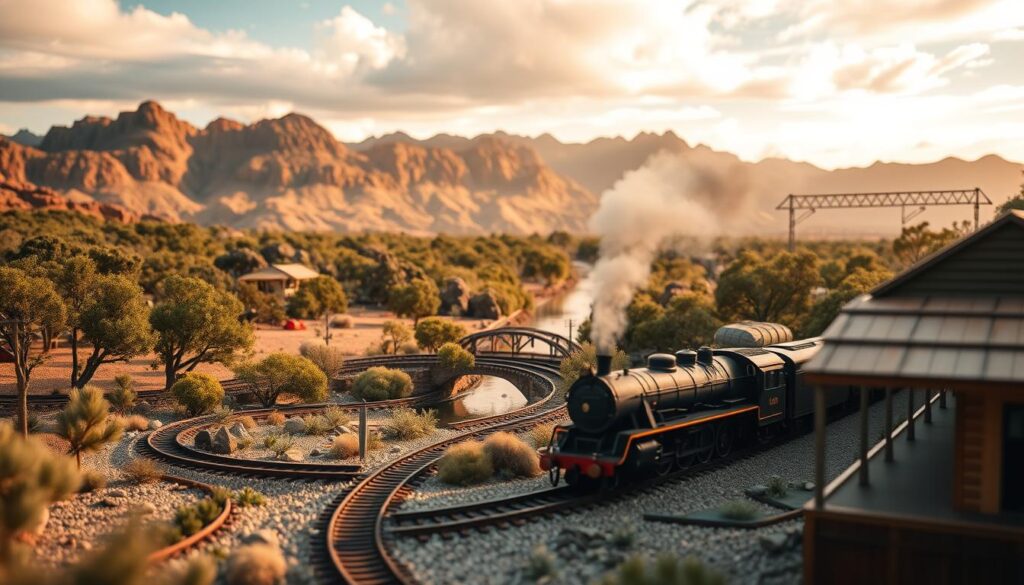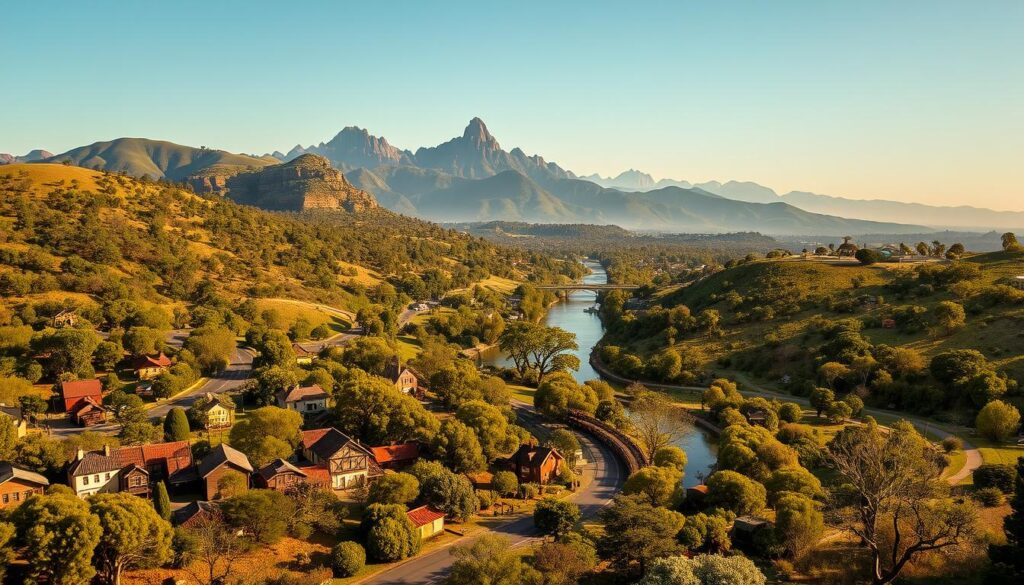Did you know that over 1,700 enthusiasts have explored the topic of N scale layouts in just one year? This hobby isn’t just about trains—it’s about crafting worlds that tell stories. My journey into Australian model railway layouts began with a deep connection to my hometown. That’s where I drew inspiration from historic locations and detailed track diagrams.
Building a layout is more than just assembling tracks and scenery. It’s about capturing the essence of a specific prototype, like the challenges of modeling the Australian landscape. Using HO and N scales, I’ve learned that every detail matters—from the placement of trees to the texture of the terrain.
This article is a step-by-step guide for hobbyists all around the world. Whether you’re new to the craft or a seasoned builder, you’ll find practical tips and examples to bring your project to life. Let’s dive into the fascinating world of scale modeling together!
Key Takeaways
- Scale modeling is a creative hobby that combines trains and storytelling.
- Researching historic locations and track diagrams is essential for authenticity.
- HO and N scales are popular choices for building detailed layouts.
- Attention to scenery and terrain adds realism to your project.
Want to build your dream model railroad? Download my FREE guide

Privacy Policy: We hate SPAM and promise to keep your email address safe
Introduction: My Journey into Down Under Model Railroading
My fascination with scale modeling began with a childhood memory of watching trains pass through my hometown. The rhythmic clatter of wheels on tracks and the billowing steam left an indelible mark on me. It wasn’t just about the trains—it was about the stories they carried and the worlds they connected.
One of my earliest inspirations came from exploring the unique railway infrastructure in Euroa, Victoria. I spent hours studying Google Maps imagery, tracing tracks, and imagining the history behind each station. This curiosity led me to dive into books and online resources, where I discovered the art of creating miniature worlds and micro model railway layouts.
My Inspiration and Personal Connection
Growing up near a bustling train yard, I developed a deep love for trains and their stories. Specific memories, like the sound of a steam whistle echoing through the valley, fueled my passion. These experiences shaped my approach to building layouts, where every detail tells a story.
Local clubs and publications played a significant role in my journey. The Australian Model Railway Magazine became a treasure trove of ideas, while my local railway club offered invaluable support and camaraderie. These influences taught me the importance of community in this hobby.
Overview of the How-To Guide
This guide is designed to walk you through every step of creating your own layout. From finding inspiration to adding the final touches, I’ll share practical tips and personal insights. Whether you’re a beginner or an experienced builder, my goal is to make the process enjoyable and rewarding.
I’ll cover essential topics like choosing the right scale, drafting track plans, and adding realistic scenery. My personal approach emphasizes creativity and attention to detail, ensuring your project reflects your unique vision. Let’s embark on this journey together and bring your miniature world to life!
Research and Planning for a Realistic Layout
Creating a realistic layout starts with careful research and thoughtful planning. This phase is where your project begins to take shape, blending historical accuracy with creative vision. I’ve found that the more effort you put into this stage, the more rewarding the final result will be.

Selecting a Location and Time Period
Choosing the right location is crucial. I focused on areas with rich historical significance, like the Cudgewa line and Euroa. These locations offered unique track plans and scenery that inspired my project. Personal interest also played a big role—I wanted to capture the essence of places that felt meaningful to me.
I also used this approach when building my Switzerland model train layout.
Next, I decided on a time period. For my layout, I chose the late 80’s to early 90’s. This era aligned with my rolling stock collections and allowed me to incorporate specific details like period-appropriate buildings and vehicles. Selecting a time frame helps ground your project in a specific context, adding depth and authenticity.
Gathering Historical and Reference Materials
Research is the foundation of any realistic layout. I spent hours studying historical photos, track diagrams, and period-specific features. Websites like victorianrailways.net were invaluable resources, providing detailed information and inspiration.
I also turned to railway publications and local clubs for additional insights. These sources helped me understand the operational nuances of real railways, which I then applied to my project. Comparing fictional elements with real-world locations, like the abandoned Cudgewa line, added a layer of realism to my design.
Remember, while historical accuracy is important, don’t be afraid to add your own creative touches. Balancing authenticity with imagination is what makes your HO scale layout truly unique.
Step-by-Step Guide to Building Authentic Australian model railway layouts
Building a miniature world starts with choosing the right scale and era to bring your vision to life. This step is crucial for ensuring your project reflects the realism and detail you desire. Let’s break down the process into manageable steps.

Choosing the Right Scale and Era
Selecting the correct scale is the first step. I primarily use HO scale because it offers a balance between detail and space efficiency. N scale is another option, especially if you’re working with a smaller area. Your choice depends on the size of your space and the level of detail you want to achieve.
Next, decide on the era. I chose the late 80’s to early 90’s for my project because it aligns with my rolling stock collection. This era also allows me to incorporate specific details like period-appropriate buildings and vehicles. Researching historical signals and track layouts from resources like victorianrailways.net can help you stay true to your chosen time period.
Drafting Your Track Layout and Scenery Plan
Once you’ve chosen the scale and era, it’s time to draft your track layout. Start by studying historical diagrams to understand how tracks were arranged in real-world locations. I used software to sketch my design, but manual drafting works just as well. The key is to create a plan that balances functionality with aesthetics.
Incorporate scenic elements early in the planning stage. Think about where mountains, rivers, or buildings will go. This helps you visualize the final product and make adjustments before you start building. Remember, the planning stage is critical for future modifications and detailed scenery work.
| Scale | Gauge | Best For |
|---|---|---|
| HO | 16.5mm | Detailed layouts with moderate space |
| N | 9mm | Small spaces or larger empires |
| O | 32mm | Large layouts with high detail |
| Z | 6.5mm | Miniature or background scenes |
By carefully selecting your scale and era, and thoughtfully drafting your layout, you’ll set a strong foundation for your project. This approach ensures your miniature world is both authentic and uniquely yours.
Incorporating Structures, Scenery, and Authentic Details
Adding structures and scenery transforms a simple layout into a vibrant, lifelike world. It’s the details that make your project stand out, from the textures of buildings to the natural elements that surround them. Let’s explore how to bring these elements together for a truly authentic experience.

Modelling Buildings, Bridges, and Infrastructure
Structures like station buildings, bridges, and tunnels are the backbone of any layout. I often start by researching real-life examples, such as the overpass at Euroa train station. Historical photos and Google Maps imagery are invaluable for capturing the essence of these features.
Scratch-building or modifying commercial models can add unique touches. For instance, I’ve used scaffold designs to create realistic loco sheds. Attention to details like color palettes and weathering techniques ensures these structures blend seamlessly into the scene.
Creating Natural Elements and Scenic Backdrops
Natural scenery is just as important as man-made structures. I focus on elements like trees, rivers, and mountains to reflect the landscape. Using materials like foam and plaster, I craft terrain that feels authentic and dynamic.
Real-life inspiration is key. I often study maps and photos to replicate specific locations. For example, the rolling hills near Euroa inspired a scenic backdrop that adds depth to my layout. Balancing natural and man-made elements creates a harmonious and believable world.
By combining detailed structures with thoughtful scenery, you can create a layout that tells a story. Every element, from a tiny bridge to a sprawling mountain, contributes to the overall realism and charm of your project.
Build Your Australian Model Railroad Today
Crafting a detailed miniature world is a journey that blends creativity and precision. From finding inspiration to adding the final touches, every step requires thoughtful planning and attention to detail. My guide walks you through selecting the right scale, drafting track plans, and incorporating authentic scenery to bring your project to life.
Effective planning and authentic detailing go hand in hand. Whether you’re a beginner or an experienced builder, this guide serves as a roadmap to help you create a layout that reflects your unique vision. Don’t hesitate to explore additional resources online or join local clubs for further inspiration and support.
Building a miniature world is both rewarding and challenging. It’s a hobby that allows you to balance technical precision with creative freedom. I encourage you to share your experiences and connect with fellow enthusiasts to enrich your passion. Thank you for joining me on this journey—now it’s your turn to bring your ideas to life!
Want to build your dream model railroad? Download my FREE guide

Privacy Policy: We hate SPAM and promise to keep your email address safe
FAQ
What inspired me to start building Down Under layouts?
My passion for railroading began with childhood memories of train journeys across Australia. The unique landscapes and rich history sparked my interest in recreating these scenes in miniature.
How do I choose the right scale and era for my project?
Start by researching the time period and region you want to replicate. Popular scales like HO or N work well for Australian themes, and selecting an era helps narrow down details like rolling stock and scenery.
What’s the best way to plan a realistic track layout?
Begin by sketching your design, considering space and prototype accuracy. Use historical maps and photos to ensure your layout reflects real-world locations and operations.
How can I add authentic details to my scenery?
Focus on natural elements like vegetation, terrain, and water features. Incorporate structures like bridges and buildings that match your chosen era and location for added realism.
Where can I find resources for historical research?
Libraries, archives, and online databases are great starting points. Eveleigh Press and local rail clubs often have valuable materials to guide your project.
What tools and materials do I need to get started?
Basic tools like track cutters, adhesives, and paint are essential. Invest in quality scenery materials like foam, plaster, and foliage to bring your layout to life.

